WHAT’S THAT YOU SAY? Future treatments may reverse hearing loss
Hearing loss is a significant disability in and out of the workplace.[1] Recent independent research studies suggest gene therapy and surgical treatment may one day be available to reverse the effects of occupational, noise-induced, sensorineural hearing loss.
The ear is a complex system of membrane, tiny bones, a fluid-filled spiral tunnel, and microscopic hair cells. Hearing occurs when pressure from sound waves vibrate the tympanic membrane, which cause tiny bones to move and create waves in a fluid-filled cavity called the cochlea.
Movement of cochlear fluid causes vibration of tiny hair cells on the corti, the sensory organ inside the cochlea, and sends signals to the auditory nerve, which transmits the signals to the brain. Loud noise increases pressure within the ear and produces violent movement of the membrane, tiny bones, and cochlear fluid, which can damage the hair cells and limit or prevent signals to the auditory nerve.
Treatment for sensorineural hearing loss is typically limited to hearing aids, designed to amplify and redirect sounds waves. Hearing aids, however, cannot reverse sensorineural hearing loss. Two recent independent studies, however, indicate gene therapy and surgical intervention may repair hair cell damage and reverse sensorineural hearing loss.
The Hearing Loss Association of America (HLAA) reports Novartis International AG, the Swiss-based pharmaceutical company, is developing a gene therapy that may reverse hearing loss by stimulating the regrowth of microscopic hair cells in the inner ear. Novartis treated the first patient in October 2014 following successful laboratory tests on rats.[2]
The New England Journal of Medicine (JAMA) reports a separate study that suggests damage to ribbon synapses associated with the cochlear hair cells necessary for hearing may be surgically repaired. The researchers have purportedly achieved synaptic regeneration following hair cell damage due to noise exposure in mice.[3]
Gene therapy and surgery are currently not approved and unavailable to treat noise-induced, sensorineural hearing loss. Whether the specific modalities and techniques reported by HLAA and JAMA will become accepted forms of treatment for occupational hearing loss is unknown and speculative. What is known, however, is medical research, knowledge and technique will continue to progress and develop. What are also highly likely and predictable is treatment other than increased volume through mechanical devices inserted into the ear will become available to treat occupational hearing loss by the end of the decade.
[1] Approximately 48 million adults in the United States, or 20 percent of the population, report some degree of hearing loss. 60 percent of people with hearing impairment participate in the work force or an educational program. Approximately 22 million workers are exposed to hazardous noise and an additional 9 million are exposed to ototoxic chemicals at work. Statistics obtain from Hearing Loss Association of America, Johns Hopkins Medicine, National Information Center on Deafness and Other Communication Disorders, National Institutes of Health, National Council on Aging, and MarkeTrack VIII Study by Sergei Kochpin, PhD; Centers for Disease Control, National Institute for Occupational Safety and Health Division of Applied Research and Technology, December 5, 2014; Department of Health and Human Services, (NIOSH), Publication Number 2010-136, March 2010.
[2] Bennett-Blumberg, Simeon, Can You Really Reverse Hearing Loss? Drugmakers Try Gene Therapy, The Hearing Loss Association of America, January 9, 2015.
[3] Cunningham, Lisa L., Tucci, Debra L., Restoring Synaptic Connections in the Inner Ear after Noise Damage, New England Journal of Medicine, Vol. 372:181-182, No. 2, January 8, 2015.
